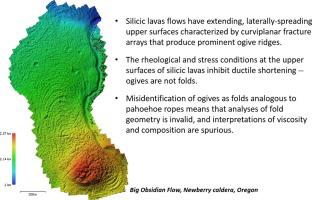当前位置:
X-MOL 学术
›
Earth Planet. Sci. Lett.
›
论文详情
Our official English website, www.x-mol.net, welcomes your
feedback! (Note: you will need to create a separate account there.)
The fold illusion: The origins and implications of ogives on silicic lavas
Earth and Planetary Science Letters ( IF 4.8 ) Pub Date : 2021-01-01 , DOI: 10.1016/j.epsl.2020.116643 Graham D.M. Andrews , Stuart M. Kenderes , Alan G. Whittington , Shelby L. Isom , Sarah R. Brown , Holly D. Pettus , Brenna G. Cole , Kailee J. Gokey
Earth and Planetary Science Letters ( IF 4.8 ) Pub Date : 2021-01-01 , DOI: 10.1016/j.epsl.2020.116643 Graham D.M. Andrews , Stuart M. Kenderes , Alan G. Whittington , Shelby L. Isom , Sarah R. Brown , Holly D. Pettus , Brenna G. Cole , Kailee J. Gokey

|
Abstract Folds on the surfaces of mafic lavas are among the most readily recognized geological structures and are used as first-order criteria for identifying ancient lavas on Earth and other planetary bodies. However, the presence of surface-folds on the surface of silicic lavas is contested in this study and we challenge the widely accepted interpretation that silicic lava surfaces contain folds using examples from the western United States and Sardinia, Italy. We interpret the ridges and troughs on their upper surfaces, typically referred to as ‘ogives’ or ‘pressure ridges’, as fracture-bound structures rather than folds. We report on the absence of large-scale, buckle-style folds and note instead the ubiquitous presence of multiple generations and scales of tensile fractures comparable to crevasses in glaciers and formed in ways similar to already recognized crease structures. We report viscosity data and results of stress analyses that preclude folding (ductile deformation in compression) of the upper surface of silicic lavas at timescales of emplacement (weeks to months). Therefore, analysis of fold geometry (wavelength, amplitude, etc.) is erroneous, and instead the signal produced reflects the strength and thickness of the brittle upper surface stretching over a ductile interior. The presence of ogives on the surfaces of lavas on other planetary bodies may help to elucidate their rheological properties and crustal thicknesses, but relating to their tensile strength, not viscosity.
中文翻译:

褶皱错觉:卵形对硅质熔岩的起源和影响
摘要 镁铁质熔岩表面的褶皱是最容易识别的地质结构之一,被用作识别地球和其他行星体上古代熔岩的一级标准。然而,在这项研究中,硅质熔岩表面上表面褶皱的存在是有争议的,我们挑战了广泛接受的解释,即硅质熔岩表面包含褶皱,使用来自美国西部和意大利撒丁岛的例子。我们将其上表面的脊和槽(通常称为“卵形”或“压力脊”)解释为裂缝约束结构而不是褶皱。我们报告没有大规模,扣式褶皱,并注意到无处不在的多代和多级拉伸断裂,类似于冰川中的裂缝,其形成方式类似于已经公认的折痕结构。我们报告了粘度数据和应力分析的结果,这些结果排除了硅质熔岩上表面在就位时间尺度(数周到数月)的折叠(压缩时的延展变形)。因此,褶皱几何形状(波长、振幅等)的分析是错误的,相反,产生的信号反映了在延展性内部伸展的脆性上表面的强度和厚度。其他行星体熔岩表面上的卵形可能有助于阐明它们的流变特性和地壳厚度,但与它们的拉伸强度有关,而不是粘度。
更新日期:2021-01-01
中文翻译:

褶皱错觉:卵形对硅质熔岩的起源和影响
摘要 镁铁质熔岩表面的褶皱是最容易识别的地质结构之一,被用作识别地球和其他行星体上古代熔岩的一级标准。然而,在这项研究中,硅质熔岩表面上表面褶皱的存在是有争议的,我们挑战了广泛接受的解释,即硅质熔岩表面包含褶皱,使用来自美国西部和意大利撒丁岛的例子。我们将其上表面的脊和槽(通常称为“卵形”或“压力脊”)解释为裂缝约束结构而不是褶皱。我们报告没有大规模,扣式褶皱,并注意到无处不在的多代和多级拉伸断裂,类似于冰川中的裂缝,其形成方式类似于已经公认的折痕结构。我们报告了粘度数据和应力分析的结果,这些结果排除了硅质熔岩上表面在就位时间尺度(数周到数月)的折叠(压缩时的延展变形)。因此,褶皱几何形状(波长、振幅等)的分析是错误的,相反,产生的信号反映了在延展性内部伸展的脆性上表面的强度和厚度。其他行星体熔岩表面上的卵形可能有助于阐明它们的流变特性和地壳厚度,但与它们的拉伸强度有关,而不是粘度。











































 京公网安备 11010802027423号
京公网安备 11010802027423号